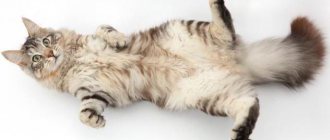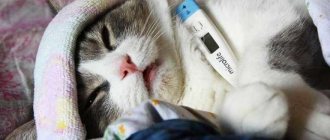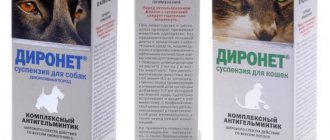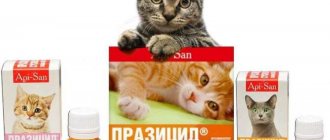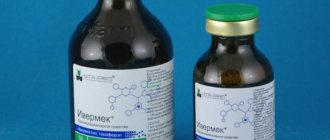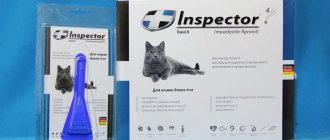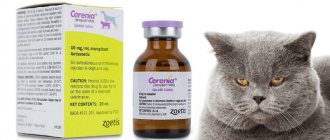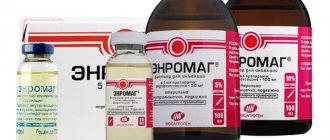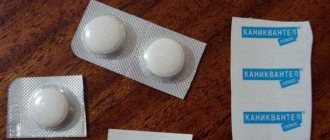Description of the drug
The therapeutic dose of Papaverine exceeds the toxic dose by 28.8 times, which allows it to be classified as low-toxic and used in veterinary practice.
The opiate alkaloid papaverine has a relaxing effect on the smooth muscles of the hollow organs of the urinary, respiratory, and digestive systems. In addition, the substance has a hypotensive (lowers blood pressure) effect, because it relaxes the muscle tissue of blood vessels.
The drug has little effect on the central nervous system, but if the dose is exceeded, a sedative effect may be observed. Accordingly, taking Papaverine helps to relieve:
- spasms;
- painful sensations of spasmodic and non-spasmodic nature.
In addition, it activates blood supply to tissues.
Cystitis, urolithiasis and other indications
Veterinarians prescribe a myotropic antispasmodic to cats for the following pathologies and conditions:
- spasm of the urinary tract;
- intestinal colic;
- cholecystitis;
- bronchospasms;
- pylorospasm;
- urolithiasis disease;
- spasm of peripheral vessels.
Papaverine belongs to the group of non-selective (non-selective) neurotropic antispasmodics. This means that the drug provides a therapeutic effect by disrupting the transmission of nerve impulses in the autonomic nerve ganglia or fibers innervating smooth muscle tissue.
To facilitate surgical and diagnostic procedures, veterinarians sometimes administer Papaverine to animals.
When is papaverine used?
spasms of smooth muscles caused by diseases of the biliary tract (cholecystitis, cholangitis, cholangiolithiasis, cholecystolithiasis, pericholecystitis, papillitis);
spasms of smooth muscles of the urinary tract with cystitis, uro- and nephrolithiasis, pyelitis, bladder tenesmus.
As an addition to the main therapy, the drug can be used to relieve spasm of smooth muscles, which is caused by diseases of the stomach and intestines. Indications for use are: peptic ulcer, flatulent forms of spastic colitis, as well as SRCT with constipation, spasms of the pylorus and cardia.
Instructions for use
How to give tablets?
Contains 10 or 40 mg of papaverine hydrochloride. In veterinary practice they are used much less frequently than other forms. Disadvantages of tablets:
- difficulties with reception;
- antispasmodic and analgesic effects occur more slowly;
- metabolized in the liver and excreted in the form of active elements, which affects the frequency of side effects;
- circulate in the blood for up to 24 hours.
The tablet has 2 intersecting marks, according to which it can be divided into 4 equal parts, but the dosage of solid forms is more difficult to calculate than liquid ones. Veterinarians prescribe tablets to cats when owners do not have the opportunity to give injections or the cat is very afraid of injections.
Shelf life: 4 years. The tablets should be stored in a dark, dry place at +8…+25°C.
Where and in what dosage should I inject the injection solution?
In this form, the drug also contains papaverine hydrochloride. 1 ml of solution contains 20 mg of active substance. The medicine is sold in ampoules. Each holds 2 ml hydrochloride and water for injection. Therefore, there is no need to dilute the drug additionally. The therapeutic effect when administered with a solution occurs faster than when treated with tablets.
A 2% solution is administered intramuscularly and subcutaneously. It is best to inject subcutaneously into the withers. Intramuscular injection into the thigh requires experience. Injections should be given by a specialist, since pain from incorrect injection can become an additional factor of spasm and stress for the cat’s body.
How many days does it take to recover after an injection?
The period for removing the solution from the body is 4-8 hours. The drug is completely absorbed into the blood and is not exposed to digestive juices, like tablets, i.e., the dosage may be lower. At the same time, the efficiency is higher.
The shelf life of the medicine in ampoules is up to 3 years. Once opened, the medication must be used within 12 hours.
Can I use candles?
In addition to papaverine hydrochloride (20 mg), rectal suppositories contain a large number of binding elements. They provide rapid transport of the active substance through the rectal mucosa into the systemic circulation. The advantages of candles are:
- painless administration of the drug;
- rapid absorption into the bloodstream;
- the possibility of administering medication when other methods are impossible, for example, with vomiting or difficulty swallowing.
The shelf life of candles in original packaging is 2 years. Keep in a dark, cool, dry place.
The dosage depends on the cat's weight. For 1 kg you need 1-2 mg of papaverine hydrochloride 2 times a day. The course of treatment depends on the severity of the pathology, the etiology of the disease, and the condition of the animal. The average duration of use is 7 days.
Self-medication, changing the dosage, or violating recommendations can lead to the development of side effects, aggravation of the pathological process, and even death.
Contraindications
Papaverine injections, tablets and rectal suppositories have a number of contraindications for use. Among them:
- liver or kidney failure;
- state of shock;
- decreased adrenal function;
- glaucoma;
- severe brain damage;
- significant stress.
The drug should be used with caution for any pathologies of the cardiovascular system and low blood pressure. In such situations, medication can only be prescribed under close veterinary supervision. The same regimen is used to administer the drug to pregnant and lactating cats. In addition, the product is not used in case of hypersensitivity to the ingredients included in its composition.
All information posted on the site is provided in accordance with the User Agreement and is not a direct instruction to action. We strongly recommend that before using any product, you must obtain a face-to-face consultation at an accredited veterinary clinic.
Side effects
Negative reactions can occur due to an overdose of the drug or due to the individual characteristics of the cat’s body. They appear in the form:
- arrhythmias;
- disturbances in the conduction of electrical signals (blockades);
- dyspeptic disorders: nausea, vomiting, stool disorders;
- general weakness, apathy;
- aggressive behavior, increased nervousness;
- reducing pressure to critical levels;
- hyperhidrosis.
The higher the dose of the drug, the stronger it affects the central nervous system, providing an inhibitory, sedative, and hypnotic effect. If the duration of treatment is exceeded, episodes of disturbances in motor activity and thought processes are observed. Over time, they develop into a stable pathology.
What to do in case of an overdose, how to relieve spasm and lethargy?
Some owners describe the condition after a drug overdose as inappropriate behavior, a frozen gaze, lethargy to the point where the animal freezes in an uncomfortable, unusual position, stops responding to a voice or name, and refuses food and water.
There is no antidote to the medicine. If your pet experiences side effects after administration of Papaverine, you should:
- stop the drug;
- rinse the stomach;
- give activated carbon;
- convenient to lay and monitor the condition.
In case of severe overdose, death may occur due to cardiac or respiratory arrest.
Is No-Spa really contraindicated for cats?
It happens that after a veterinarian prescribes a course of treatment for his four-legged patient, his owner sits down in front of the computer, so... discuss the prescriptions... and is horrified by what he learns from “informed and enlightened”, excuse me, experienced animal owners.
And after that, to treat the animal with medications prescribed by the doctor... you just can’t raise your hand... But for some reason, no one wants to take responsibility for treating your pet, except you and that “bad” doctor, it’s just too much to frighten everyone.
And so such an owner hangs “between Scylla and Charybdis”... And the advisers scared and left, and the doctor is already afraid to believe.
In our materials we will try to explain the contradictions that you may encounter between your doctor’s prescriptions and established opinions among “experienced” animal lovers.
Today we will talk about the widespread opinion among cat lovers (and among some veterinarians) that the use of the drug “No-shpa” is contraindicated for cats. Moreover, by default the conversation is about the injection form.
Why is it contraindicated?
I will quote the most frequent answers from opponents of the use of the drug “No-spa” in cats:
- The cat's back legs are taken away from him
- After the injection of No-shpa, the cat went limp as a rag and only resuscitation could save her
- A cat after No-shpa may remain lame for life
- No-spa causes paresis of the pelvic limbs
- My cat was injected with No-shpu - then she could barely walk and limped for a long time
And so on…
As you can see, the most often mentioned is the impairment of the ability to use the pelvic limbs after injection of the drug “No-spa” or its analogues containing Drotaverine hydrochloride.
And as analogues, Papaverine hydrochloride is immediately proposed as a “much safer” analogue.
Therefore, to begin with, we will try to find significant differences between these drugs in order to understand why someone believes that Papaverine hydrochloride is much safer for cats than Drotaverine hydrochloride (No-spa). By the way, in what follows I will mainly use the non-proprietary name of the active ingredient of the drug “No-shpa” - Drotaverine hydrochloride. It will be more accurate that way.
Comparison of the properties of Papaverine and Drotaverine hydrochloride (the drug "No-shpa")
Historical information: Drotaverine hydrochloride was synthesized at the Hinoin enterprise in 1961 on the basis of Papaverine, which had long been produced at the enterprise. So the drugs have a common origin.
Mechanism of antispasmodic action: both Papaverine and Drotaverine have an antispasmodic effect based on inhibition of the enzyme PDE-phosphodiesterase, the concentration of which in tissues determines the effectiveness of the use of Drotaverine and Papaverine in clinical practice. Under the influence of PDE inhibitors, the amount of cAMP (cycloadenosine monophosphate) in the cell increases and the amount of calcium ions decreases. And the fewer calcium ions in the cell, the lower the possibility of muscle fiber contraction. The result of this is a decrease in the tone and motor activity of the smooth muscles of the internal organs, which leads to the elimination of their spasm.
Duration and strength of antispasmodic action: Drotaverine has a half-life of 7-12 hours, while Papaverine has a half-life of only 1.5 - 2 hours. At the same time, the selectivity of the effect on smooth muscles of Drotaverine is 5 times higher than that of Papaverine.
pH of the injection solution: the degree of acidity of the administered solution of Papaverine and Drotaverine is 3-4.5, which indicates a possible local reaction with intramuscular and subcutaneous administration,
Metabolism of drugs: both drugs are metabolized in the liver and are excreted in the form of metabolites by the kidneys - Papaverine completely, Drotaverine - more than 50% (approximately 30% is excreted in the intestines with bile).
Penetration into tissues: Papaverine penetrates the blood-brain barrier and into all tissues; Drotaverine does not penetrate the central nervous system and does not affect the autonomic nervous system; it slightly passes through the placental barrier.
As can be seen from the comparison, some properties of the drugs Papaverine hydrochloride and Drotaverine hydrochloride are very similar, and the existing differences determine individual indications for the use of one or another drug.
However, if we are talking about the mechanism that causes the antispasmodic effect, the characteristics of metabolism and the direct effect on the smooth muscles of internal organs and blood vessels, then they are almost identical for both drugs. This means that there is no reason to say that one drug (Drotaverine) can cause reactions in cats that another drug (Papaverine) cannot cause.
What is the difference in the reaction of cats to the administration of drugs?
It all depends on several important points in the condition and reaction of the body of a particular cat:
- Individual sensitivity of a cat to a drug
- Previous condition of the cat before the antispasmodic injection
- Local reactions to drug administration.
Let's take a closer look at each of these points:
Individual sensitivity of a cat to a drug
As we have already mentioned, the more phosphodiesterase enzyme (PDE) in animal tissues, the stronger the antispasmodic effect of any drug will be - be it Papaverine or Drotaverine, but to Papaverine such a reaction will be about 5 times shorter.
Allergic and paradoxical reactions of a living organism to the administration of drugs occur regardless of the type of animal and the type of drug.
In addition, no one has canceled the paradoxical reactions of a cat’s body (as well as any warm-blooded creature) to the administration of ANY drug. Often, for example, cats begin to “foam” when drugs are administered (intramuscular or intravenous).
Excessive discharge of foamy saliva from the mouth can be associated both with the animal’s stress reaction to the environment of the veterinary clinic and the treatment process itself, and with the chemical effect of the administered drug on the cat’s body.
Foaming at the mouth of a cat when drugs are administered, either orally or injected, may be a paradoxical response of the cat's autonomic nervous system to stress as a result of treatment.
When Papaverine is administered, such reactions can be significantly (about 5 times) weaker and shorter, which is due to the lower selectivity of this drug, the possible sedative effect of Papaverine and the faster half-life of Papaverine compared to Drotaverine hydrochloride.
Owners sometimes call this the “softer” action of Papaverine compared to the action of Drotaverine.
Previous condition of the cat before the antispasmodic injection
Many owners do not take into account the fact that prolonged pain, which is accompanied by spasms of hollow organs (intestines, bladder), often keeps the animal’s nervous system in good shape even when almost all of the body’s “reserves” have already been exhausted (prolonged erectile phase of pain shock).
This is especially true for dehydrated animals and animals in a state of hypoglycemia. As soon as, thanks to the injection of an antispasmodic, the pain syndrome sharply loses its intensity, the torpid phase of pain shock begins: a sharp inhibition of all signals of the nervous system, entailing a drop in pressure (collapse). The animal suddenly relaxes (hangs like a rag), its reactions to external stimuli sharply decrease, the pressure drops sharply, which worsens the blood supply to the brain and often resuscitation measures simply cannot be avoided.
As can be seen from the description, this is not a side effect of the antispasmodic, but a natural pathogenetic process in the development of pain shock.
This is often observed with feline urethral syndrome (if urine output has stopped abruptly for more than a day) and with some types of dynamic intestinal obstruction, when sharp spasms and profuse distension of the intestine are observed as a result of gas formation.
That is why self-medication of animals in serious condition is unacceptable, because often the owner cannot take into account all the mechanisms that operate in the body of a seriously ill patient.
Self-medication of animals in serious condition, especially with the use of antispasmodics and analgesics, is unacceptable!
Local reactions to drug administration
As mentioned above, solutions of both Drotaverine and Papaverine have an acidic reaction. Because of this, it is extremely undesirable for cats to inject such drugs into the subcutaneous or intermuscular (interfascial) fatty tissue. The consequence of such an injection will be a painful area of irritation at the site of injection of the drug, up to the formation of an inflammatory infiltrate.
It is advisable to administer Papaverine and Drotaverine deeply intramuscularly.
But it happens that due to too small and poorly developed muscles (for example, in a kitten), the drug gets into the interfascial, paraneural or perivascular fatty tissue. In this case, a local reaction of the surrounding tissues to the acidic solution occurs. Brief soreness is possible, which is accompanied by lameness, as well as the development of a reactive inflammatory infiltrate.
Such an infiltrate will be more painful if it covers a nerve branch or is adjacent to the vascular wall, where there are more pain receptors. At the same time, if we take into account the possible (reactive) slowdown in absorption and the half-life of the drug, it becomes clear that the reaction to Drotaverine may be brighter and longer than to Papaverine.
If we consider that, as a rule, injections are given to cats specifically in the pelvic limbs, it becomes clear why a patient, after a few days of treatment with antispasmodic injections, may simply refuse to walk on his paws, every movement of which causes pain.
This problem can be reduced by using dry heat to accelerate the resorption of post-injection infiltrates.
Which drug do you prefer?
In order to wisely and consciously choose what to use as an antispasmodic for a cat, it is necessary to take into account all the common points and differences in the properties of Drotaverine and Papaverine, which were reflected above.
What I advise you to focus on:
- Required duration of antispasmodic action
- Presence and severity of pain before using an antispasmodic
- The general effect that is expected from the use of an antispasmodic in a cat
- Individual reactions of cats to previous use of antispasmodics
Now let's look at all the landmarks in more detail:
Required duration of antispasmodic action
If the spasm is not severe and/or short-lived, then an injection of papaverine is sufficient to relieve it.
If you need a long-term antispasmodic effect with minimal impact on the central nervous system, then it is more logical to choose Drotaverine hydrochloride (“No-spa”)
So, if there is a need for ongoing monitoring of small intestinal spasms due to an infectious or invasive disease (especially in a kitten), I will prefer to use Papaverine, and in case of severe spastic pain due to poisoning, idiopathic cystitis, or with urolithiasis and urethral syndrome in cats, I will certainly choose Drotaverine hydrochloride
Presence and severity of pain before using an antispasmodic
The higher the patient’s level of pain and the longer the duration of this pain, the more additional measures I will take to avoid getting that very torpid phase of shock. Before using an antispasmodic, I will catheterize a vein to administer drugs drip and maintain the patient’s pressure, and then I will use the antispasmodic that I deem necessary based on the above. If the effect on the central nervous system is undesirable, my preference will be given to Drotaverine.
The general effect that is expected from the use of an antispasmodic in a cat
If I use an antispasmodic only for the purpose of relieving an acute spasm in an animal free of chronic diseases, then I will focus on the required duration of the antispasmodic effect. If antispasmodics are used in an animal that has a number of chronic diseases, then the use of the antispasmodic begins to be limited by the patient’s body’s ability to administer the drug.
Considering the metabolism of the drugs in question in the liver, I would prefer to prescribe Papaverine to animals with suspected chronic liver pathology, slowing down the metabolism of which can affect my patient’s body more positively than negatively. In the case of Drotaverine, a slowdown in the metabolism of the drug can become more fatal for the patient due to its longer persistence in the body and, accordingly, higher risks of accumulation.
Individual reactions of cats to previous use of antispasmodics
This point, it seems to me, needs little comment. It is clear that if previous experience with a particular antispasmodic was unsuccessful, then next time you should use a different drug and hope that the patient’s body will react to it in accordance with the best expectations of the doctor and owner.
Sometimes it happens that simply changing the treatment environment or injection technique significantly changes the cat's reactions to the administration of the drug. And this should also be taken into account when planning treatment for a patient.
Conclusion
We hope that our materials have shown you, dear reader, how many factors should be taken into account when choosing drugs to treat a particular patient.
Therefore, if you are the owner of an animal and it seems to you that this or that drug may be dangerous for your pet, ask your doctor to justify his prescription of this particular drug. It is possible that after a medical explanation everything will turn out to be not so terrible, but quite justified. And if something goes wrong, then contacting a doctor will help explain the problems that have arisen and quickly change the drug with an undesirable effect or the technique of its use.
Be sure to discuss with your doctor all your fears and concerns about using a particular drug.
This is much better than silently listening to the doctor, and then independently using advice from the Internet to change treatment at your own peril and risk, or to scold an innocent doctor for something that will not happen if you follow all the recommendations.
If you are a veterinarian, then when prescribing this or that drug, follow not myths and fears, but the knowledge of pharmacology, pathophysiology and clinical disciplines.
We will be glad if you would like to discuss our materials in letters, comments to an article on the site or in our groups!
Natalya Troshina, veterinarian (DVM)
Sources of information about medicines:
- https://madbear.info/kaltsij.htmlhttps://ru.wikipedia.org/wiki/Drotaverine
- https://ru.wikipedia.org/wiki/Papaverine
- https://www.gastroscan.ru/handbook/144/1485
- https://zdravotvet.ru/no-shpa-instrukciya-po-primeneniyu-protivopokazaniya-pobochnye-dejstviya-pokazaniya-dozirovka/
Reviews
Owners
Carolina, 34, Kovrov:
“I give my cat Papaverine when she starts screaming in the litter box. I have to give her medications regularly because she has severe inflammation in her ureters, bladder and kidney stones. I give papaverine according to the regimen recommended by the veterinarian.”
Pavel 32 years old, Orel:
“My wife and I invited guests to our new apartment. The table was set. Our Briton Timokha loves to eat. Therefore, he sucked up to all the guests. Someone will give you a piece of sausage, someone will give you smoked fish...
By morning the cat became very ill. The veterinary clinics are all closed, and Timofey is fading away before our eyes. It's good that my friend is a therapist. He advised giving the pet ½ tablet of Papaverine. He got better, but since then I lock him in the bedroom when guests come.”
Alina, 43 g, Bobruisk:
“Papaverine became firmly established in our cat pharmacy 1-2 years after Murcello was neutered. Often he cannot go “small”. He yells, but it makes no sense. If you give him half a tablet, after a while he will pee freely and walk calmly until the next exacerbation.”
Veterinarians
Tatyana, 35 years old, veterinarian:
“Often owners give cats medications without prescription. It is impossible to count how many pets are then brought in with an overdose of Papaverine. This medicine should not be given randomly. Just the other day we failed to save an old cat. She died in my arms."
Kirill, 44 years old, veterinarian:
“I use Papaverine as a premedication before surgery on the urinary system in cats. It’s much easier to work with - the pet becomes calmer, a little anesthetic is required, and this causes less harm to the body.”
Possibility of overdose
Important!
You cannot use “Papaverine” without consulting and prescribing a veterinarian!
Due to incorrect calculation of the volume of the drug per animal weight, an overdose may occur. Its consequences may be:
- loss of vision (temporary or permanent);
- arrhythmia;
- disturbances in vision (double vision);
- headache, nausea;
- paresis of the hind limbs;
- strong sedative effect;
- decreased excitability of the heart muscle.
In case of overdose, you must immediately stop using the drug and remove it from the body as quickly as possible and ensure that blood pressure is maintained. Gastric lavage (when taking pills) and enterosorbents are prescribed. Do not let the animal eat until it has been examined by a specialist.
You can watch a video on how to inject a cat subcutaneously (at the withers):
Owner reviews
Nina, owner of a 3-year-old cat:
“When our cat Timofey grew up, he had to be neutered, since there are two other cats living in the house. After a while, he was diagnosed with urolithiasis and treated, quite effectively. A couple of months later, an attack occurred - the cat could not go to the toilet, and when it did, there was blood in the urine. I had to go to the clinic again. The doctor prescribed Papaverine and other medications. After just a couple of days the cat felt much better. Problems with urination are now a thing of the past.”
Dmitry, owner of a Persian cat:
“My cat never goes outside; at most she can walk on the windowsill. Despite this, I contracted cystitis somewhere. I noticed that it sits in the tray for a long time, and only a couple of drops come out. The first time they drained urine using a catheter, then they started injecting Papaverine. The cat felt better and began to urinate on its own. The drug is cheap and effective.”
Overdose
A large dose of the drug provokes toxic poisoning.
Regardless of whether the drug was administered intramuscularly or subcutaneously, if the dosage is exceeded, pronounced symptoms of side effects may occur. Cats often experience vomiting and weakness. If an overdose occurs, it is important to take appropriate action immediately. When there is no way to quickly contact a veterinarian, you need to rinse the cat’s stomach yourself using warm water or a solution of potassium permanganate. You should not feed your pet until your veterinarian has examined it.
After contacting a specialist, you will need to give the animal enterosorbents, which improve the functioning of the gastrointestinal tract. The veterinarian draws the attention of cat owners to the fact that Papaverine and barbiturates should not be used together. In such a situation, the general condition of the animal deteriorates greatly. If a person notices that after using the described pharmaceutical product the cat feels worse than usual, this should also be reported to a specialist. The doctor will be able to calculate a new dosage or prescribe an analog medication for the treatment of a diagnosed disease.
Release form, composition and mechanism of operation
“Papaverine” is supplied to pharmacy chains in tablets, injection solution and rectal suppositories. All these forms of release are successfully used for the treatment of various diseases in cats. The composition contains the main component called papaverine hydrochloride. Additional ingredients are purified water, talc, magnesium stearate and potato starch. With the help of the medication, it is possible to reduce the intracellular calcium content, relax smooth muscles, and dilate the arteries. Papaverine helps increase blood flow and reduce excitability.
